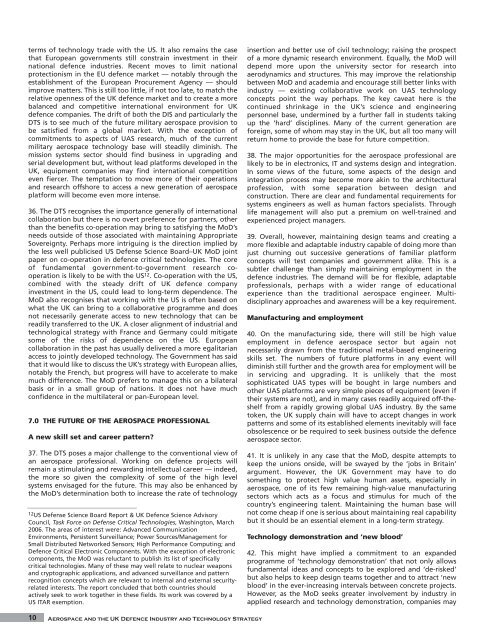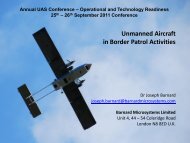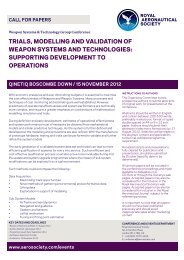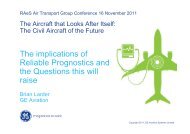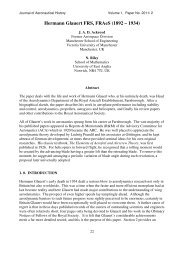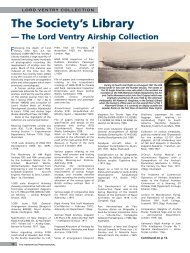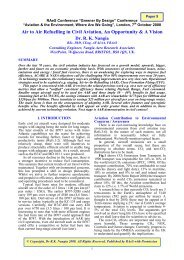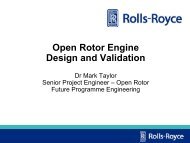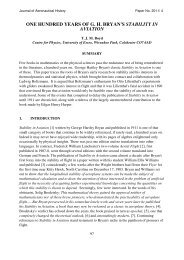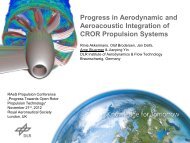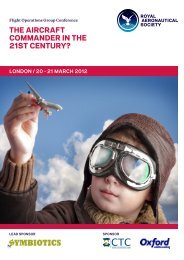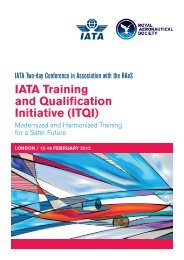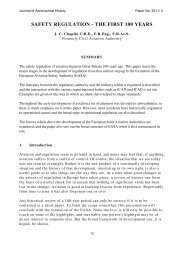DTS Paper.qxp - Royal Aeronautical Society
DTS Paper.qxp - Royal Aeronautical Society
DTS Paper.qxp - Royal Aeronautical Society
You also want an ePaper? Increase the reach of your titles
YUMPU automatically turns print PDFs into web optimized ePapers that Google loves.
terms of technology trade with the US. It also remains the case<br />
that European governments still constrain investment in their<br />
national defence industries. Recent moves to limit national<br />
protectionism in the EU defence market — notably through the<br />
establishment of the European Procurement Agency — should<br />
improve matters. This is still too little, if not too late, to match the<br />
relative openness of the UK defence market and to create a more<br />
balanced and competitive international environment for UK<br />
defence companies. The drift of both the DIS and particularly the<br />
<strong>DTS</strong> is to see much of the future military aerospace provision to<br />
be satisfied from a global market. With the exception of<br />
commitments to aspects of UAS research, much of the current<br />
military aerospace technology base will steadily diminish. The<br />
mission systems sector should find business in upgrading and<br />
serial development but, without lead platforms developed in the<br />
UK, equipment companies may find international competition<br />
even fiercer. The temptation to move more of their operations<br />
and research offshore to access a new generation of aerospace<br />
platform will become even more intense.<br />
36. The <strong>DTS</strong> recognises the importance generally of international<br />
collaboration but there is no overt preference for partners, other<br />
than the benefits co-operation may bring to satisfying the MoD’s<br />
needs outside of those associated with maintaining Appropriate<br />
Sovereignty. Perhaps more intriguing is the direction implied by<br />
the less well publicised US Defense Science Board–UK MoD joint<br />
paper on co-operation in defence critical technologies. The core<br />
of fundamental government-to-government research cooperation<br />
is likely to be with the US 12. Co-operation with the US,<br />
combined with the steady drift of UK defence company<br />
investment in the US, could lead to long-term dependence. The<br />
MoD also recognises that working with the US is often based on<br />
what the UK can bring to a collaborative programme and does<br />
not necessarily generate access to new technology that can be<br />
readily transferred to the UK. A closer alignment of industrial and<br />
technological strategy with France and Germany could mitigate<br />
some of the risks of dependence on the US. European<br />
collaboration in the past has usually delivered a more egalitarian<br />
access to jointly developed technology. The Government has said<br />
that it would like to discuss the UK’s strategy with European allies,<br />
notably the French, but progress will have to accelerate to make<br />
much difference. The MoD prefers to manage this on a bilateral<br />
basis or in a small group of nations. It does not have much<br />
confidence in the multilateral or pan-European level.<br />
7.0 THE FUTURE OF THE AEROSPACE PROFESSIONAL<br />
A new skill set and career pattern?<br />
37. The <strong>DTS</strong> poses a major challenge to the conventional view of<br />
an aerospace professional. Working on defence projects will<br />
remain a stimulating and rewarding intellectual career — indeed,<br />
the more so given the complexity of some of the high level<br />
systems envisaged for the future. This may also be enhanced by<br />
the MoD’s determination both to increase the rate of technology<br />
12 US Defense Science Board Report & UK Defence Science Advisory<br />
Council, Task Force on Defense Critical Technologies, Washington, March<br />
2006. The areas of interest were: Advanced Communication<br />
Environments, Persistent Surveillance; Power Sources/Management for<br />
Small Distributed Networked Sensors; High Performance Computing; and<br />
Defence Critical Electronic Components. With the exception of electronic<br />
components, the MoD was reluctant to publish its list of specifically<br />
critical technologies. Many of these may well relate to nuclear weapons<br />
and cryptographic applications, and advanced surveillance and pattern<br />
recognition concepts which are relevant to internal and external securityrelated<br />
interests. The report concluded that both countries should<br />
actively seek to work together in these fields. Its work was covered by a<br />
US ITAR exemption.<br />
10<br />
Aerospace and the UK Defence Industry and Technology Strategy<br />
insertion and better use of civil technology; raising the prospect<br />
of a more dynamic research environment. Equally, the MoD will<br />
depend more upon the university sector for research into<br />
aerodynamics and structures. This may improve the relationship<br />
between MoD and academia and encourage still better links with<br />
industry — existing collaborative work on UAS technology<br />
concepts point the way perhaps. The key caveat here is the<br />
continued shrinkage in the UK’s science and engineering<br />
personnel base, undermined by a further fall in students taking<br />
up the ‘hard’ disciplines. Many of the current generation are<br />
foreign, some of whom may stay in the UK, but all too many will<br />
return home to provide the base for future competition.<br />
38. The major opportunities for the aerospace professional are<br />
likely to be in electronics, IT and systems design and integration.<br />
In some views of the future, some aspects of the design and<br />
integration process may become more akin to the architectural<br />
profession, with some separation between design and<br />
construction. There are clear and fundamental requirements for<br />
systems engineers as well as human factors specialists. Through<br />
life management will also put a premium on well-trained and<br />
experienced project managers.<br />
39. Overall, however, maintaining design teams and creating a<br />
more flexible and adaptable industry capable of doing more than<br />
just churning out successive generations of familiar platform<br />
concepts will test companies and government alike. This is a<br />
subtler challenge than simply maintaining employment in the<br />
defence industries. The demand will be for flexible, adaptable<br />
professionals, perhaps with a wider range of educational<br />
experience than the traditional aerospace engineer. Multidisciplinary<br />
approaches and awareness will be a key requirement.<br />
Manufacturing and employment<br />
40. On the manufacturing side, there will still be high value<br />
employment in defence aerospace sector but again not<br />
necessarily drawn from the traditional metal-based engineering<br />
skills set. The numbers of future platforms in any event will<br />
diminish still further and the growth area for employment will be<br />
in servicing and upgrading. It is unlikely that the most<br />
sophisticated UAS types will be bought in large numbers and<br />
other UAS platforms are very simple pieces of equipment (even if<br />
their systems are not), and in many cases readily acquired off-theshelf<br />
from a rapidly growing global UAS industry. By the same<br />
token, the UK supply chain will have to accept changes in work<br />
patterns and some of its established elements inevitably will face<br />
obsolescence or be required to seek business outside the defence<br />
aerospace sector.<br />
41. It is unlikely in any case that the MoD, despite attempts to<br />
keep the unions onside, will be swayed by the ‘jobs in Britain’<br />
argument. However, the UK Government may have to do<br />
something to protect high value human assets, especially in<br />
aerospace, one of its few remaining high-value manufacturing<br />
sectors which acts as a focus and stimulus for much of the<br />
country’s engineering talent. Maintaining the human base will<br />
not come cheap if one is serious about maintaining real capability<br />
but it should be an essential element in a long-term strategy.<br />
Technology demonstration and ‘new blood’<br />
42. This might have implied a commitment to an expanded<br />
programme of ‘technology demonstration’ that not only allows<br />
fundamental ideas and concepts to be explored and ‘de-risked’<br />
but also helps to keep design teams together and to attract ‘new<br />
blood’ in the ever-increasing intervals between concrete projects.<br />
However, as the MoD seeks greater involvement by industry in<br />
applied research and technology demonstration, companies may


